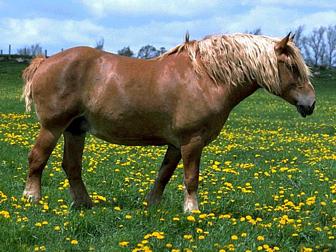
OVERVIEW
From the time of Julius Caesar's occupation of what is now Belgium, the Belgian horse has enjoyed a great reputation as a powerful and versatile horse. The Belgian Draft Horse is called the Brabant horse in Europe, and in America it is called the Belgian. The Belgian is the descendant of the type of horse used by knights as war horses. Richard the Lionhearted imported many Belgians to England. When the mounted knight became obsolete, the Belgian's strength was utilized in agriculture. The Belgian has been exported throughout the world to improve local stock. It has greatly influenced the Shire, Clydesdale, and Suffolk Punch of Britain, and the Rheinesh Horse of Germany.
PHYSICAL DESCRIPTION
The Belgian usually exceeds 16 hands in height and very often exceeds 18 hands. It is a docile horse and a willing worker. The American Belgian has a relatively large head and short, feathered, muscular legs and large quarters. The feet are large and have minimum feather. In America, its color is usually chestnut or roan with white or blonde mane, tail and points. Its weight averages between 1800 and 2000 pounds; some stallions reach 2400.
ORIGIN
The Belgian Draft Horse is descended from the war horse of the Middle Ages. Its location of origin is Brabant, in what is now Belgium. Belgians, as the breed is known in America, differ slightly from its European ancestor the Brabant. American dealers imported mostly sorrel stock, and these colors were passed on through subsequent generations.
INTERESTING FACTS
The first Belgian was imported to America by Dr. A. G. Van Hoorebeck of Illinois in 1866. The Belgian is the most popular work horse in America.
INFLUENCES
1. Flanders Horse
For more information:
Belgian Draft Horse Corporation of America
Listed as "Recovering" by The American Livestock Breeds Conservancy (2004)